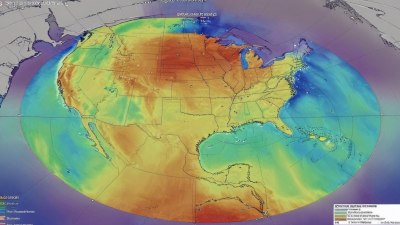What Causes Warm Ocean Currents
Explore the factors leading to the formation of warm ocean currents and their impact on global climate.

Warm ocean currents play a pivotal role in regulating the Earth's climate and weather patterns. Understanding what causes these currents is essential for grasping their significance in the broader context of oceanography. Several factors contribute to the development of warm ocean currents, including the sun's energy, wind patterns, and the Earth's rotation. Each of these factors interacts in complex ways to produce the necessary conditions for warm water to flow through the oceans.
Solar Radiation
The sun is the primary source of energy for the Earth. Solar radiation heats the surface of the ocean unevenly due to variations in latitude, seasons, and geographic features. The equator receives more direct sunlight than the poles, leading to an increase in water temperature in these regions. The warm water at the equator is less dense and more buoyant than the cooler water found at higher latitudes. This temperature differential provides the impetus for warm ocean currents to form as they move from warmer to cooler regions, redistributing heat around the globe.
Wind Patterns
Wind patterns are another critical factor influencing the movement of warm ocean currents. The interaction between the atmosphere and the ocean surface generates wind-driven currents. The trade winds, easterlies that typically blow from east to west in the tropics, are instrumental in pushing warm water westward across the Pacific Ocean. As the warm water accumulates in the western part of the ocean basin, it creates a significant temperature difference, prompting the formation of warm ocean currents like the Kuroshio Current. The Coriolis effect, stemming from the Earth's rotation, also affects the direction of these currents, causing them to veer to the right in the Northern Hemisphere and to the left in the Southern Hemisphere.
Thermohaline Circulation
Thermohaline circulation, often referred to as the ocean conveyor belt, is crucial for understanding how warm ocean currents function alongside cold currents. This phenomenon is driven by differences in water density which is affected by temperature (thermo) and salinity (haline). Warm water, being less dense, tends to rise, while cold, salty water sinks. This circulation pattern helps to distribute warmth from the equator towards the poles and facilitates the formation of warm currents like the Gulf Stream, which carries warm water northward along the eastern coast of North America and across the Atlantic Ocean toward Europe.
Coastal upwelling occurs when winds push surface waters away from the shore, allowing colder, nutrient-rich waters to rise to the surface. While upwelling itself is primarily associated with cooler currents, it can also influence the temperature of adjacent warm currents. For instance, the warm water in areas close to upwelling zones can be affected by the mixing of cooler water, which can enhance the productivity and ecological balance of the region, as well as modify the currents' thermal characteristics.
Ocean Heat Content and Climate Change
Climate change is causing significant alterations in ocean temperature and currents. As global temperatures rise, ocean waters absorb excess heat, affecting the distribution of warm and cold currents. This can lead to a destabilization of existing current patterns, which may cause changes in weather systems, contribute to extreme weather events, and disrupt marine ecosystems. The warming of ocean currents like the Gulf Stream is already associated with various environmental issues, including rising sea levels and changes to precipitation patterns across North America and Europe.
Influence of Geography
The geography of the ocean basin is another essential factor in determining the characteristics and pathways of warm ocean currents. Coastal features, continental shelves, and underwater topography all interact with ocean currents, affecting their direction and speed. For example, the Sargasso Sea in the North Atlantic is surrounded by several currents, including the Gulf Stream, which creates a unique environment that supports a distinct marine ecosystem. Additionally, the landmasses they encounter can redirect and concentrate currents, reinforcing their strength and effectiveness in transferring heat.
Biological Impacts
Warm ocean currents influence marine life in various ways. Areas where warm currents flow are often rich in biodiversity as warm water can support a greater abundance of plankton, which forms the foundation of the marine food web. Such currents can also create migration pathways for various species, impacting fisheries and coastal economies. For instance, the availability of warm waters can attract migratory fish species that rely on specific temperature ranges for breeding and growth.
Examples of Warm Ocean Currents
Many warm ocean currents have significant impacts on the climate and ecosystems of adjoining regions. The Gulf Stream, for example, warms much of the Eastern United States and Western Europe, significantly amending their climate. In contrast, the Kuroshio Current in the Northwest Pacific Ocean brings warmth from the equator to Japan, influencing weather and fishing industries. Similarly, the Agulhas Current flows along the southeast coast of Africa, transporting warm water into the Atlantic Ocean, which affects both local conditions and global climate patterns.
In conclusion, the formation of warm ocean currents is a multifaceted process driven by solar radiation, wind patterns, thermohaline circulation, and geographical features. These currents significantly affect not only regional climates but also global weather systems. With the impacts of climate change affecting the oceans, understanding what causes warm ocean currents becomes increasingly critical. The interconnectedness of ocean currents with marine ecosystems, weather patterns, and even global economies highlights the importance of ongoing research in oceanography and environmental science. Continued monitoring and study will be necessary to predict and manage the effects of changing ocean currents in the future.











